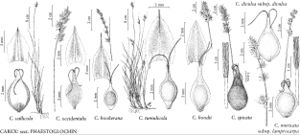Difference between revisions of "Carex tumulicola"
Bull. Torrey Bot. Club 34: 154. 1907.
FNA>Volume Importer |
FNA>Volume Importer |
||
| Line 31: | Line 31: | ||
-->{{#Taxon: | -->{{#Taxon: | ||
name=Carex tumulicola | name=Carex tumulicola | ||
| − | |||
|authority=Mackenzie | |authority=Mackenzie | ||
|rank=species | |rank=species | ||
| Line 46: | Line 45: | ||
|publication year=1907 | |publication year=1907 | ||
|special status= | |special status= | ||
| − | |source xml=https://jpend@bitbucket.org/aafc-mbb/fna-data-curation.git/src/ | + | |source xml=https://jpend@bitbucket.org/aafc-mbb/fna-data-curation.git/src/f50eec43f223ca0e34566be0b046453a0960e173/coarse_grained_fna_xml/V23/V23_496.xml |
|genus=Carex | |genus=Carex | ||
|section=Carex sect. Phaestoglochin | |section=Carex sect. Phaestoglochin | ||
Revision as of 21:08, 16 December 2019
Plants with short, stout rhizomes. Culms 20–80 cm, 1–1.6 mm wide basally, 0.5–0.8 mm wide distally. Leaves: sheaths tight, green, fronts hyaline; ligules less than 2 mm, wider than long; widest leaf blades 1.5–2.5 mm wide, papillose adaxially. Inflorescences with 3–10 spikes, 1.5–5 cm × 5–8 mm; proximal internodes slightly shorter than to 2 times as long as proximal spikes; proximal bracts 1–5 cm; spikes with to 10 erect perigynia. Pistillate scales brown with green midvein, ovate, 3.3–5.2 × 2–2.8 mm, body as long as and wider than perigynium, apex awned, awn less than 1 mm. Anthers 1.9–2.4 mm. Perigynia pale green to pale brown, veinless or veined, 3.5–5 × 1.5–2 mm, base slightly spongy, thickened, margins serrulate distally; beak 1–3 mm, apical teeth 0.3–0.6 mm. Styles straight, 0.05 mm wide. Achenes elliptic-circular, 2–2.4 × 1.4–1.7 mm.
Phenology: Fruiting late spring–early summer.
Habitat: Grasslands, forest openings
Elevation: 30–1200 m
Distribution

B.C., Calif., Oreg., Wash.
Discussion
Selected References
None.
